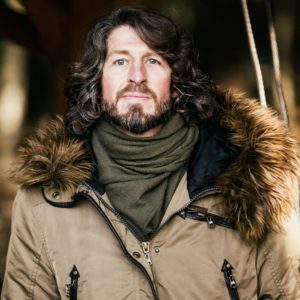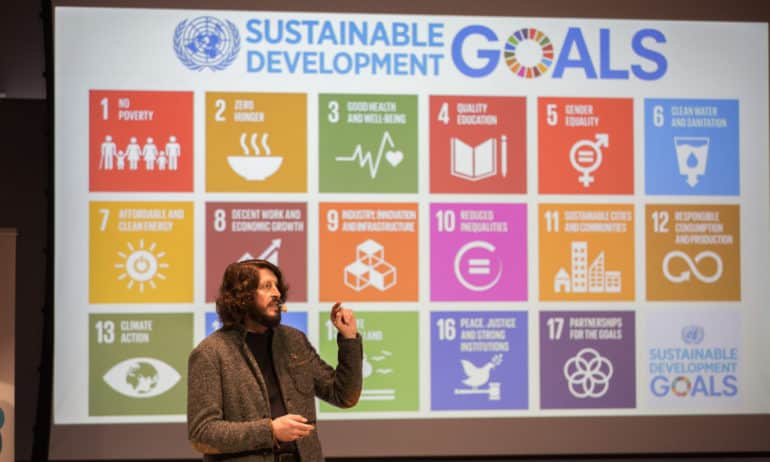Photographs courtesy of Marc Buckley.
Marc Buckley is calling for “a paradigm shift in how we view the world.” This food leader and advocate for the United Nations Sustainable Development Goals (SDGs) wants us to think differently: “We as humanity have gotten into this modus of looking at things very straight and linear, putting everything in boxes and silos,” he tells Food Tank, “but that’s not how our world works. Our world works in complex, dynamic systems.”

Marc wears many hats. In addition to serving as a U.N. SDG Advocate, he is the co-founder and CEO of the food and beverage company ANJA GmbH & Co. KG (Adaptive Nutrition, Joint Achievements) and a member of the World Economic Forum’s Expert Network. He also works with the World Food Programme and the U.N. Food and Agriculture Organization (FAO). Though he speaks at events all over the world, he tells Food Tank that “the things I talk about are really hard to do in an elevator pitch or a TED Talk because they are based on complexity and systems thinking.” We had the opportunity to speak with Marc about some of this complexity and how to work toward a more sustainable future.
Marc tells Food Tank that “all 17 SDGs are tied to food, agriculture, and the food and beverage industry,” as shown in the wedding cake model by Johann Rockström, Director of the Stockholm Resilience Centre, and Pavan Sukhdev, Study Leader of The Economics of Ecosystems and Biodiversity (TEEB). The SDGs, Marc explains, not only reflect “the very basics of Maslow’s hierarchy of needs,” but also are interconnected through resources like those we need to make food. “To be around well into the future and deal with our finite resources,” he says, “we need to view the SDGs as a complex system, all tied to each other and working in harmony. If you work on one, there is no way you cannot work on some of the others.”
Reaching the SDGs by 2030, Marc adds, will require both funding and action, and “the number one way to stop and reverse global warming is to globally reform food, to change our entire food system into something that is sustainable.” But sustainability alone will not be enough: “We need to think about resilience because we went beyond the limits to growth.” Facing threats like floods, droughts, and famines, “how can we build sustainable development infrastructures that will take us through these times of unknown?” This is an urgent question; in talking about recovery in Puerto Rico after Hurricane Maria, Marc notes, “We need to be able to eat every day, so we can’t wait four or five years to figure it out.”
The need for resilient systems requires a systems approach, and Marc is not alone in taking this perspective. “Everywhere you see,” he says, “whether it’s the EAT Forum or the World Economic Forum or the United Nations, they talk about this dynamic modeling or systems approach because they know this linear, solid view of the world isn’t working anymore.” Marc uses the human body as an analogy to help explain systems thinking: “Our bodies are made up of 11 complex systems that all work together in complete harmony. There’s no one system of those 11 that controls your whole body or all the other systems, but if one of those systems breaks down and you get sick, the other systems compensate, they try to recover, and that’s a complex ecosystem every day going on in your body.”
“The way we can reach the SDGs and the future is to have more innovations around food and people who come up with solutions based on dynamic models or complex systems thinking,” Marc says. In fact, this concept underlies his company, ANJA, and its ALOHAS ECO-Center. He hopes the ECO-Center will show other industry players that more sustainable food production is possible: “There’s no more excuses. There’s no more stealing water. There’s no more creating other problems. It’s time to do it. And I think that shift will occur when they can see it.”
Marc started ANJA with his wife Anja because they wanted to see more sustainable, fair trade, organic, and environmentally-friendly products providing consumers with healthy options in any circumstance. They had been making their own drinks and other products and wanted to make them more widely available. But using other facilities for processes like cold packing and filling, they discovered that “it’s not very sustainable; there’s a lot of compromises. The product that we want isn’t the product that comes out in the end.” So they decided to take matters into their own hands, realizing that “our product is not our products; our product is how we produce.”
The 40-hectare ECO-Center facility uses an enclosed environment agricultural system and generates, harvests, and recycles resources. For example, Marc and his team use renewable energy sources like wind and solar and save surplus energy in backup batteries. They also harvest water from humidity in the air and filter rainwater to grow plants and make beverages. Eight floors in the ECO-Center house about 7,000 hectares of harvestable vertical farming space. Marc tells Food Tank that in this facility, he also wants retailers to educate consumers and sell products to help people produce food sustainably at home, like small ambient water harvesters, vertical farm refrigerators, and solar panels.
Although he emphasizes the urgent need for resilient systems, Marc maintains a positive outlook. “I just jump out of bed every day,” Marc says of his work with ANJA and the ALOHAS ECO-Center. “I know that there are problems in the industry, but they are all solvable. We haven’t dug ourselves so deep that we are stuck into any kind of system, so I am really hopeful to see that future.”
Marc Buckley will be speaking at the Seeds & Chips summit on May 8th and 10th, during sessions titled “Controlled Environments: The Billion Dollar Future of Indoor & Vertical Farming” and “Sustainability as Survival: Solutions for Our Common Good.”











